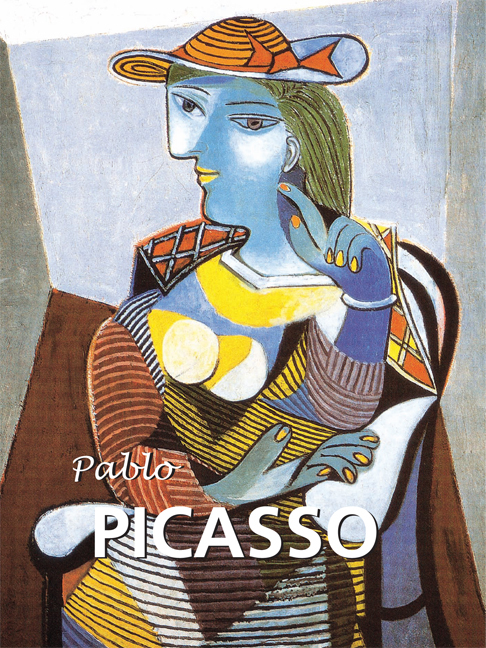Электронная книга: Victoria Charles «Pablo Picasso»

|
Серия: "Great Masters" Picasso was born a Spaniard and, so they say, began to draw before he could speak. As an infant he was instinctively attracted to artist’s tools. In early childhood he could spend hours in happy concentration drawing spirals with a sense and meaning known only to himself. At other times, shunning children’s games, he traced his first pictures in the sand. This early self-expression held out promise of a rare gift. M?laga must bementioned, for it was there, on 25 October 1881, that Pablo Ruiz Picasso was born and it was there that he spent the first ten years of his life. Picasso’s father was a painter and professor at the School of Fine Arts and Crafts. Picasso learnt from him the basics of formal academic art training. Then he studied at the Academy of Arts in Madrid but never finished his degree. Picasso, who was not yet eighteen, had reached the point of his greatest rebelliousness; he repudiated academia’s anemic aesthetics along with realism’s pedestrian prose and, quite naturally, joined those who calledthemselves modernists, the non-conformist artists and writers, those whom Sabart?s called “the ?lite of Catalan thought” and who were grouped around the artists’ caf? Els Quatre Gats. During 1899 and 1900 the only subjects Picasso deemed worthy of painting were those which reflected the “final truth”; the transience of human life and the inevitability of death. His early works, ranged under the name of “Blue Period” (1901-1904), consist in blue-tinted paintings influenced by a trip through Spain and the death of his friend, Casagemas. Even though Picasso himself repeatedly insisted on the inner, subjective nature of the Blue Period, its genesis and, especially, the monochromatic blue were for many years explained as merely the results of various aesthetic influences. Between 1905 and 1907, Picasso entered a new phase, called “Rose Period” characterised by a more cheerful style with orange and pink colours. In Gosol, in the summer of 1906 the nude female form assumed an extraordinary importance for Picasso; he equated a depersonalised, aboriginal, simple nakedness with the concept of “woman”. The importance that female nudes were to assume as subjects for Picasso in the next few months (in the winter and spring of 1907) came when he developed the composition of the large painting, Les Demoiselles d’Avignon. Just as African art is usually considered the factor leading to the development of Picasso’s classic aesthetics in 1907, the lessons of C?zanne are perceived as the cornerstone of this new progression. This relates, first of all, to a spatial conception of the canvas as a composed entity, subjected to a certain constructive system. Georges Braque, with whom Picasso became friends in the autumn of 1908 and together with whom he led Cubism during the six years of its apogee, was amazed by the similarity of Picasso’s pictorial experiments to his own. He explained that: “Cubism’s main direction was the materialisation of space.” After his Cubist period, in the 1920s, Picasso returned to a more figurative style and got closer to thesurrealist movement. He represented distorted and monstrous bodies but in a very personal style. After the bombing of Guernica during 1937, Picasso made one of his most famous works which starkly symbolises the horrors of that war and, indeed, all wars. In the 1960s, his art changed again and Picasso began looking at the art of great masters and based his paintings on ones by Vel?zquez, Poussin, Goya, Manet, Courbet and Delacroix. Picasso’s final works were a mixture of style, becoming more colourful, expressive and optimistic. Picasso died in 1973, in his villa in Mougins. The Russian Symbolist Georgy Chulkov wrote: “Picasso’s death is tragic. Yet how blind and na?ve are those who believe in imitating Picasso and learning from him. Learning what? For these forms have no corresponding emotions outside of Hell. But to be in Hell means to anticipate death. The Cubists are hardly privy to such unlimited knowledge”. Издательство: "Parkstone International Publishing"
ISBN: 978-1-78042-299-2 электронная книга |
Другие книги автора:
| Книга | Описание | Год | Цена | Тип книги |
|---|---|---|---|---|
| Franz Marc | Condemned by the Nazis as a degenerate artist, Franz Marc was a German painter whose stark linearity and emotive use of color eloquently expressed the pain and trauma of war. In work such as his… — Parkstone Press, (формат: 150x170, 256 стр.) Подробнее... | бумажная книга |
См. также в других словарях:
Pablo Picasso — im Jahr 1962 Pablo Picasso, eigentlich Pablo Ruiz Picasso, (* 25. Oktober 1881 in Málaga, Spanien; † 8. April 1973 in Mougins, Frankreich … Deutsch Wikipedia
Pablo Picasso — «Picasso» redirige aquí. Para otras acepciones, véase Picasso (desambiguación). Pablo Picasso Foto de Pablo Picasso (enero de 1962) … Wikipedia Español
Pablo picasso — Pour les articles homonymes, voir Picasso (homonymie). Pab … Wikipédia en Français
Pablo Picasso — Pablo Ruiz Picasso (25 de octubre de 1881 8 de abril de 1973), más conocido como Pablo Picasso, fue un pintor, dibujante y escultor español, nacido en Málaga (España). Fue uno de los grandes maestros del siglo XX, quizá el artista que más fama ha … Enciclopedia Universal
Pablo Picasso — This article is about the artist. For other uses, see Picasso (disambiguation). This name uses Spanish naming customs; the first or paternal family name is Ruiz and the second or maternal family name is Picasso … Wikipedia
Pablo Picasso — « Picasso » redirige ici. Pour les autres significations, voir Picasso (homonymie) … Wikipédia en Français
